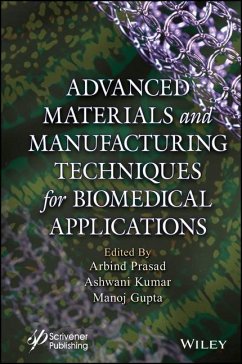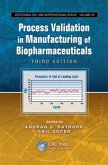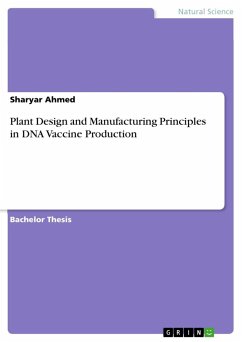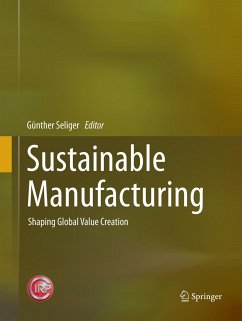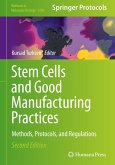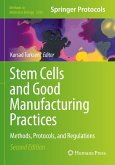Advanced Materials and Manufacturing Techniques for Biomedical Applications
Herausgeber: Prasad, Arbind; Gupta, Manoj; Kumar, Ashwani
Advanced Materials and Manufacturing Techniques for Biomedical Applications
Herausgeber: Prasad, Arbind; Gupta, Manoj; Kumar, Ashwani
- Gebundenes Buch
- Merkliste
- Auf die Merkliste
- Bewerten Bewerten
- Teilen
- Produkt teilen
- Produkterinnerung
- Produkterinnerung
The book provides essential knowledge for the synthesis of biomedical products, development, nanomaterial properties, fabrication processes, and design techniques for different applications, as well as process design and optimization. In origin, biomaterials can come from nature or be synthesized in the laboratory with a variety of approaches that use metals, polymers, ceramic, or composite materials. They are often used or adapted for various biomedical applications. Biomaterials are commonly used in scaffolds, orthopedic, wound healing, fracture fixation, surgical sutures, artificial organ…mehr
Andere Kunden interessierten sich auch für
![Process Validation in Manufacturing of Biopharmaceuticals Process Validation in Manufacturing of Biopharmaceuticals]() Process Validation in Manufacturing of Biopharmaceuticals305,99 €
Process Validation in Manufacturing of Biopharmaceuticals305,99 €![Acoustic Emission and Durability of Composite Materials Acoustic Emission and Durability of Composite Materials]() Nathalie GodinAcoustic Emission and Durability of Composite Materials187,99 €
Nathalie GodinAcoustic Emission and Durability of Composite Materials187,99 €![Plant Design and Manufacturing Principles in DNA Vaccine Production Plant Design and Manufacturing Principles in DNA Vaccine Production]() Sharyar AhmedPlant Design and Manufacturing Principles in DNA Vaccine Production17,95 €
Sharyar AhmedPlant Design and Manufacturing Principles in DNA Vaccine Production17,95 €![Sustainable Manufacturing Sustainable Manufacturing]() Sustainable Manufacturing117,99 €
Sustainable Manufacturing117,99 €![Current Trends in Monoclonal Antibody Development and Manufacturing Current Trends in Monoclonal Antibody Development and Manufacturing]() Current Trends in Monoclonal Antibody Development and Manufacturing158,99 €
Current Trends in Monoclonal Antibody Development and Manufacturing158,99 €![Stem Cells and Good Manufacturing Practices Stem Cells and Good Manufacturing Practices]() Stem Cells and Good Manufacturing Practices123,99 €
Stem Cells and Good Manufacturing Practices123,99 €![Stem Cells and Good Manufacturing Practices Stem Cells and Good Manufacturing Practices]() Stem Cells and Good Manufacturing Practices93,99 €
Stem Cells and Good Manufacturing Practices93,99 €-
-
-
The book provides essential knowledge for the synthesis of biomedical products, development, nanomaterial properties, fabrication processes, and design techniques for different applications, as well as process design and optimization. In origin, biomaterials can come from nature or be synthesized in the laboratory with a variety of approaches that use metals, polymers, ceramic, or composite materials. They are often used or adapted for various biomedical applications. Biomaterials are commonly used in scaffolds, orthopedic, wound healing, fracture fixation, surgical sutures, artificial organ developments, pins and screws to stabilize fractures, surgical mesh, breast implants, artificial ligaments and tendons, and drug delivery systems. The sixteen chapters in Advanced Materials and Manufacturing Techniques in Biomedical Applications cover the synthesis, processing, design, manufacturing, and characterization of advanced materials; self-healing, bioinspired, nature-resourced, nanobiomaterials for biomedical applications; and manufacturing techniques such as rapid prototyping, additive manufacturing, etc. Audience The book is for engineers, technologists, and researchers working in the area of biomedical engineering and manufacturing techniques. It is also appropriate for upper-level undergraduate and graduate students.
Hinweis: Dieser Artikel kann nur an eine deutsche Lieferadresse ausgeliefert werden.
Hinweis: Dieser Artikel kann nur an eine deutsche Lieferadresse ausgeliefert werden.
Produktdetails
- Produktdetails
- Verlag: Wiley
- Seitenzahl: 464
- Erscheinungstermin: 19. Dezember 2023
- Englisch
- Gewicht: 948g
- ISBN-13: 9781394166190
- ISBN-10: 1394166192
- Artikelnr.: 66402107
- Herstellerkennzeichnung
- Libri GmbH
- Europaallee 1
- 36244 Bad Hersfeld
- gpsr@libri.de
- Verlag: Wiley
- Seitenzahl: 464
- Erscheinungstermin: 19. Dezember 2023
- Englisch
- Gewicht: 948g
- ISBN-13: 9781394166190
- ISBN-10: 1394166192
- Artikelnr.: 66402107
- Herstellerkennzeichnung
- Libri GmbH
- Europaallee 1
- 36244 Bad Hersfeld
- gpsr@libri.de
Arbind Prasad, PhD, obtained his doctorate from the Indian Institute of Technology Guwahati, Assam. He is currently an assistant professor and Head in the Department of Science and Technology, Government of Bihar, Posted at Katihar Engineering College, Katihar, Bihar, India. His main areas of interest include manufacturing, machining, polymer composites, biomaterials, materials processing, and orthopedic biomedical applications He has filled four patents, published more than 10 international journal articles, and edited three books. Ashwani Kumar, PhD, is a senior lecturer in mechanical engineering at the Technical Education Department, Uttar Pradesh (Government of Uttar Pradesh), India. He has more than 11 years of research and academic experience in mechanical and materials engineering. He has published 85 research articles in international journals and has authored/edited 13 books on mechanical and materials engineering. Manoj Gupta, PhD, was a former Head of the Materials Division of the Mechanical Engineering Department at the National University of Singapore. He has published more than 600 peer-reviewed journal articles and owns two US patents and one trade secret. He has also co-authored eight books. He is currently among the top 0.6% of researchers as per Stanford's List and among the top 1% Scientist of the World Position by The Universal Scientific Education and Research Network.
Preface xix
Acknowledgement xxi
Section I: Advanced Materials for Biomedical Applications 1
1 Introduction to Next-Generation Materials for Biomedical Applications 3
Arbind Prasad, Sudipto Datta, Ashwani Kumar and Manoj Gupta
1.1 Introduction 4
1.2 Advanced Functional Materials 5
1.3 Market and Requirement of Next-Generation Materials 7
1.4 Metals and Polymeric Biomaterials 8
1.5 Bioabsorbable Biomaterials 8
1.6 Processing of Bioabsorbable Polymeric Biomaterials 9
1.7 Application of Next-Generation Materials in Biomedical Applications 11
1.8 Latest Status of Next Generation Materials in ineering 13
1.9 Bioresorbable Devices for Skin Tissue Engineering 14
1.10 Challenges and Perspectives 15
1.11 Conclusion 16
2 Advanced Materials for Surgical Tools and Biomedical Implants 25
Sudipto Datta and Ranjit Barua
2.1 Introduction 26
2.2 Application of Bioengineering to Healthcare 28
2.3 Application in Musculoskeletal and Orthopedic Medicines 30
2.4 Application as a Disposable Medical Device 30
2.5 Application as an Implantable Biosensor 32
2.6 Conclusions 33
3 Insights into Multifunctional Smart Hydrogels in Wound Healing
Applications 37
Sriparna De, Dipankar Das, Arbind Prasad, Ashwani Kumar and Dipankar
Chattopadhyay
3.1 Introduction 38
3.2 Architecture of Fabricated Hydrogels 40
3.3 Bactericidal Effect on Wound Repair 41
3.4 New Frontiers of Hydrogels in Wound Dressing Applications 44
3.5 Conclusion and Future Perspectives 50
4 Natural Resource-Based Nanobiomaterials: A Sustainable Material for
Biomedical Applications 61
Monika Singh, Murchana Changmai, Tabli Ghosh and Anugraha Karwa
4.1 Introduction 62
4.2 Natural Resource-Based Biopolymer 65
4.3 Extraction of Nature Resource-Based Nanomaterials 70
4.4 Biomedical Applications of Nature Resource-Based Nanomaterials and
Their Nanobiocomposites 75
4.5 Other Applications 88
5 Biodegradable Magnesium Composites for Orthopedic Applications 103
Anshu Dubey, Satish Jaiswal, S. Vincent and Vignesh Kumaravel
5.1 Introduction 104
5.2 Materials and Methods 113
5.3 Results and Discussion 118
5.4 Conclusion and Future Outlook 126
6 New Frontiers of Bioinspired Polymer Nanocomposite for Biomedical
Applications 135
Sonika, Gopikishan Sabavath, Sushil Kumar Verma, Ram Swaroop and Arbind
Prasad
6.1 Introduction 136
6.2 Methods to Prepare Graphene-Based Polymer Nanocomposites 138
6.3 Magnetic Material - Polymer Nanocomposites 139
6.4 Nanostructured Composites 146
6.5 Conclusion and Future Trends 147
7 Nanohydroxyapatite-Based Composite Materials and Processing 157
Atanu Kumar Paul, Shasanka Sekhar Borkotoky and Arbind Prasad
7.1 Introduction 158
7.2 Biomaterials 159
7.3 Types of Biomaterials 160
7.4 Structure of Hydroxyapatite 161
7.5 Nanohydroxyapatite 165
7.6 Cancer Detection and Cell Imaging 171
7.7 Conclusion 173
8 Self-Healing Materials and Hydrogel for Biomedical Application 185
Arabinda Majhi, Megha Dhiman, Partha Roy and Debrupa Lahiri
8.1 Introduction 186
8.2 Self-Healing Hydrogels 187
8.3 Mechanism of Self-Healing in Hydrogels 188
8.4 Application of Self-Healing Hydrogel in Biomedical Application 199
8.5 Conclusion and Future Prospects 206
Section II: Advanced Manufacturing Techniques for Biomedical Applications
211
9 Biomimetic and Bioinspired Composite Processing for Biomedical
Applications 213
Hemant Kumar, Purnima Justa, Nancy Jaswal, Balaram Pani and Pramod Kumar
9.1 Introduction 214
9.2 Synthesis of Biomimetic and Bioinspired Composite 216
9.3 Biomaterials for Biomedical Applications 218
9.4 Bioinspired Materials 221
9.5 Biomimetic Drug Delivery Systems 224
9.6 Artificial Organs 226
9.7 Neuroprosthetics 229
9.8 Conclusion 232
10 3D Printing in Drug Delivery and Healthcare 241
B. Mahesh Krishna, Francis Luther King M., G. Robert Singh and A. Gopichand
10.1 Introduction 242
10.2 3D Printing in Healthcare Technologies 243
10.3 Four Dimensions Printing (4D) 243
10.4 Transformation Process and Materials 244
10.5 3D Printing's Pharmaceutical Potentials 247
10.6 Drug Administration Routes 250
10.7 Custom Design 3D Printed Pharmaceuticals 253
10.8 Excipient Selection for 3D Printing Custom Designs 254
10.9 Customized Medicating of Drugs 255
10.10 Devices for Personalized Topical Treatment 257
10.11 Conclusion 262
11 3D Printing in Biomedical Applications: Techniques and Emerging Trends
275
Gourhari Chakraborty and Atanu Kumar Paul
11.1 Introduction 275
11.2 3D Printing Technologies 277
11.3 Materials for 3D Printing 282
11.4 Biomedical Applications: Recent Trends of 3D-Printing 288
11.5 Challenges and Opportunities 292
11.6 Conclusion 292
12 Self-Sustained Nanobiomaterials: Innovative Materials for Biomedical
Applications 303
Sudipto Datta, Samir Das and Ranjit Barua
12.1 Introduction 304
12.2 Nanobiomaterials Applications 309
12.3 Challenge in the Clinical Rendition of Nanobiomaterials 316
12.4 Conclusion and Future Directions 318
13 Residual Stress Analysis in Titanium Alloys Used for Biomedical
Applications 325
Gulshan Kumar, Rohit Kumar and Arshpreet Singh
13.1 Introduction 326
13.2 Methodology 331
13.3 Results and Discussion 335
13.4 Conclusions 341
14 Challenges and Perspective of Manufacturing Techniques in Biomedical
Applications 345
Francis Luther King M., G. Robert Singh, A. Gopichand and Srinivasan V.
14.1 Introduction 346
14.2 3D Printing Applications in the Biomedical Field 347
14.3 Multi-Functional Materials in 3D Printing 351
14.4 Merits of AM in Medical Field 354
14.5 Major Challenges of AM in Medical Field 355
14.6 Major Challenges of AM 357
14.7 Problems Encountered When Processing 360
14.8 Challenges in Management 365
14.9 Conclusion 369
15 Metal 3D Printing for Emerging Healthcare Applications 383
Sudipto Datta, Yusuf Olatunji Waidi and Arbind Prasad
15.1 Introduction 383
15.2 Metallic 3D Printing Methods for Biomedical Applications 384
15.3 Biometals 3D Printing 391
15.4 Future Direction and Challenges 397
16 Additive Manufacturing for the Development of Artificial Organs 411
Sudipto Datta, Ranjit Barua and Arbind Prasad
16.1 Introduction 412
16.2 3D Printing of Biomaterials 413
16.3 Main Mechanisms of 3D Printing for Organ and Tissue Printing 414
16.4 Techniques to Fabricate Tissues and Organs Using 3D Printing 416
16.5 Application of 3D Printing in Implants and Drug Delivery 416
16.6 Application 3D Printing in Orthotics and Prosthetics 417
16.7 3D Printing Application in Tissue Engineering 417
16.8 Future Scope 419
16.9 Conclusion 419
References 420
Index 429
Acknowledgement xxi
Section I: Advanced Materials for Biomedical Applications 1
1 Introduction to Next-Generation Materials for Biomedical Applications 3
Arbind Prasad, Sudipto Datta, Ashwani Kumar and Manoj Gupta
1.1 Introduction 4
1.2 Advanced Functional Materials 5
1.3 Market and Requirement of Next-Generation Materials 7
1.4 Metals and Polymeric Biomaterials 8
1.5 Bioabsorbable Biomaterials 8
1.6 Processing of Bioabsorbable Polymeric Biomaterials 9
1.7 Application of Next-Generation Materials in Biomedical Applications 11
1.8 Latest Status of Next Generation Materials in ineering 13
1.9 Bioresorbable Devices for Skin Tissue Engineering 14
1.10 Challenges and Perspectives 15
1.11 Conclusion 16
2 Advanced Materials for Surgical Tools and Biomedical Implants 25
Sudipto Datta and Ranjit Barua
2.1 Introduction 26
2.2 Application of Bioengineering to Healthcare 28
2.3 Application in Musculoskeletal and Orthopedic Medicines 30
2.4 Application as a Disposable Medical Device 30
2.5 Application as an Implantable Biosensor 32
2.6 Conclusions 33
3 Insights into Multifunctional Smart Hydrogels in Wound Healing
Applications 37
Sriparna De, Dipankar Das, Arbind Prasad, Ashwani Kumar and Dipankar
Chattopadhyay
3.1 Introduction 38
3.2 Architecture of Fabricated Hydrogels 40
3.3 Bactericidal Effect on Wound Repair 41
3.4 New Frontiers of Hydrogels in Wound Dressing Applications 44
3.5 Conclusion and Future Perspectives 50
4 Natural Resource-Based Nanobiomaterials: A Sustainable Material for
Biomedical Applications 61
Monika Singh, Murchana Changmai, Tabli Ghosh and Anugraha Karwa
4.1 Introduction 62
4.2 Natural Resource-Based Biopolymer 65
4.3 Extraction of Nature Resource-Based Nanomaterials 70
4.4 Biomedical Applications of Nature Resource-Based Nanomaterials and
Their Nanobiocomposites 75
4.5 Other Applications 88
5 Biodegradable Magnesium Composites for Orthopedic Applications 103
Anshu Dubey, Satish Jaiswal, S. Vincent and Vignesh Kumaravel
5.1 Introduction 104
5.2 Materials and Methods 113
5.3 Results and Discussion 118
5.4 Conclusion and Future Outlook 126
6 New Frontiers of Bioinspired Polymer Nanocomposite for Biomedical
Applications 135
Sonika, Gopikishan Sabavath, Sushil Kumar Verma, Ram Swaroop and Arbind
Prasad
6.1 Introduction 136
6.2 Methods to Prepare Graphene-Based Polymer Nanocomposites 138
6.3 Magnetic Material - Polymer Nanocomposites 139
6.4 Nanostructured Composites 146
6.5 Conclusion and Future Trends 147
7 Nanohydroxyapatite-Based Composite Materials and Processing 157
Atanu Kumar Paul, Shasanka Sekhar Borkotoky and Arbind Prasad
7.1 Introduction 158
7.2 Biomaterials 159
7.3 Types of Biomaterials 160
7.4 Structure of Hydroxyapatite 161
7.5 Nanohydroxyapatite 165
7.6 Cancer Detection and Cell Imaging 171
7.7 Conclusion 173
8 Self-Healing Materials and Hydrogel for Biomedical Application 185
Arabinda Majhi, Megha Dhiman, Partha Roy and Debrupa Lahiri
8.1 Introduction 186
8.2 Self-Healing Hydrogels 187
8.3 Mechanism of Self-Healing in Hydrogels 188
8.4 Application of Self-Healing Hydrogel in Biomedical Application 199
8.5 Conclusion and Future Prospects 206
Section II: Advanced Manufacturing Techniques for Biomedical Applications
211
9 Biomimetic and Bioinspired Composite Processing for Biomedical
Applications 213
Hemant Kumar, Purnima Justa, Nancy Jaswal, Balaram Pani and Pramod Kumar
9.1 Introduction 214
9.2 Synthesis of Biomimetic and Bioinspired Composite 216
9.3 Biomaterials for Biomedical Applications 218
9.4 Bioinspired Materials 221
9.5 Biomimetic Drug Delivery Systems 224
9.6 Artificial Organs 226
9.7 Neuroprosthetics 229
9.8 Conclusion 232
10 3D Printing in Drug Delivery and Healthcare 241
B. Mahesh Krishna, Francis Luther King M., G. Robert Singh and A. Gopichand
10.1 Introduction 242
10.2 3D Printing in Healthcare Technologies 243
10.3 Four Dimensions Printing (4D) 243
10.4 Transformation Process and Materials 244
10.5 3D Printing's Pharmaceutical Potentials 247
10.6 Drug Administration Routes 250
10.7 Custom Design 3D Printed Pharmaceuticals 253
10.8 Excipient Selection for 3D Printing Custom Designs 254
10.9 Customized Medicating of Drugs 255
10.10 Devices for Personalized Topical Treatment 257
10.11 Conclusion 262
11 3D Printing in Biomedical Applications: Techniques and Emerging Trends
275
Gourhari Chakraborty and Atanu Kumar Paul
11.1 Introduction 275
11.2 3D Printing Technologies 277
11.3 Materials for 3D Printing 282
11.4 Biomedical Applications: Recent Trends of 3D-Printing 288
11.5 Challenges and Opportunities 292
11.6 Conclusion 292
12 Self-Sustained Nanobiomaterials: Innovative Materials for Biomedical
Applications 303
Sudipto Datta, Samir Das and Ranjit Barua
12.1 Introduction 304
12.2 Nanobiomaterials Applications 309
12.3 Challenge in the Clinical Rendition of Nanobiomaterials 316
12.4 Conclusion and Future Directions 318
13 Residual Stress Analysis in Titanium Alloys Used for Biomedical
Applications 325
Gulshan Kumar, Rohit Kumar and Arshpreet Singh
13.1 Introduction 326
13.2 Methodology 331
13.3 Results and Discussion 335
13.4 Conclusions 341
14 Challenges and Perspective of Manufacturing Techniques in Biomedical
Applications 345
Francis Luther King M., G. Robert Singh, A. Gopichand and Srinivasan V.
14.1 Introduction 346
14.2 3D Printing Applications in the Biomedical Field 347
14.3 Multi-Functional Materials in 3D Printing 351
14.4 Merits of AM in Medical Field 354
14.5 Major Challenges of AM in Medical Field 355
14.6 Major Challenges of AM 357
14.7 Problems Encountered When Processing 360
14.8 Challenges in Management 365
14.9 Conclusion 369
15 Metal 3D Printing for Emerging Healthcare Applications 383
Sudipto Datta, Yusuf Olatunji Waidi and Arbind Prasad
15.1 Introduction 383
15.2 Metallic 3D Printing Methods for Biomedical Applications 384
15.3 Biometals 3D Printing 391
15.4 Future Direction and Challenges 397
16 Additive Manufacturing for the Development of Artificial Organs 411
Sudipto Datta, Ranjit Barua and Arbind Prasad
16.1 Introduction 412
16.2 3D Printing of Biomaterials 413
16.3 Main Mechanisms of 3D Printing for Organ and Tissue Printing 414
16.4 Techniques to Fabricate Tissues and Organs Using 3D Printing 416
16.5 Application of 3D Printing in Implants and Drug Delivery 416
16.6 Application 3D Printing in Orthotics and Prosthetics 417
16.7 3D Printing Application in Tissue Engineering 417
16.8 Future Scope 419
16.9 Conclusion 419
References 420
Index 429
Preface xix
Acknowledgement xxi
Section I: Advanced Materials for Biomedical Applications 1
1 Introduction to Next-Generation Materials for Biomedical Applications 3
Arbind Prasad, Sudipto Datta, Ashwani Kumar and Manoj Gupta
1.1 Introduction 4
1.2 Advanced Functional Materials 5
1.3 Market and Requirement of Next-Generation Materials 7
1.4 Metals and Polymeric Biomaterials 8
1.5 Bioabsorbable Biomaterials 8
1.6 Processing of Bioabsorbable Polymeric Biomaterials 9
1.7 Application of Next-Generation Materials in Biomedical Applications 11
1.8 Latest Status of Next Generation Materials in ineering 13
1.9 Bioresorbable Devices for Skin Tissue Engineering 14
1.10 Challenges and Perspectives 15
1.11 Conclusion 16
2 Advanced Materials for Surgical Tools and Biomedical Implants 25
Sudipto Datta and Ranjit Barua
2.1 Introduction 26
2.2 Application of Bioengineering to Healthcare 28
2.3 Application in Musculoskeletal and Orthopedic Medicines 30
2.4 Application as a Disposable Medical Device 30
2.5 Application as an Implantable Biosensor 32
2.6 Conclusions 33
3 Insights into Multifunctional Smart Hydrogels in Wound Healing
Applications 37
Sriparna De, Dipankar Das, Arbind Prasad, Ashwani Kumar and Dipankar
Chattopadhyay
3.1 Introduction 38
3.2 Architecture of Fabricated Hydrogels 40
3.3 Bactericidal Effect on Wound Repair 41
3.4 New Frontiers of Hydrogels in Wound Dressing Applications 44
3.5 Conclusion and Future Perspectives 50
4 Natural Resource-Based Nanobiomaterials: A Sustainable Material for
Biomedical Applications 61
Monika Singh, Murchana Changmai, Tabli Ghosh and Anugraha Karwa
4.1 Introduction 62
4.2 Natural Resource-Based Biopolymer 65
4.3 Extraction of Nature Resource-Based Nanomaterials 70
4.4 Biomedical Applications of Nature Resource-Based Nanomaterials and
Their Nanobiocomposites 75
4.5 Other Applications 88
5 Biodegradable Magnesium Composites for Orthopedic Applications 103
Anshu Dubey, Satish Jaiswal, S. Vincent and Vignesh Kumaravel
5.1 Introduction 104
5.2 Materials and Methods 113
5.3 Results and Discussion 118
5.4 Conclusion and Future Outlook 126
6 New Frontiers of Bioinspired Polymer Nanocomposite for Biomedical
Applications 135
Sonika, Gopikishan Sabavath, Sushil Kumar Verma, Ram Swaroop and Arbind
Prasad
6.1 Introduction 136
6.2 Methods to Prepare Graphene-Based Polymer Nanocomposites 138
6.3 Magnetic Material - Polymer Nanocomposites 139
6.4 Nanostructured Composites 146
6.5 Conclusion and Future Trends 147
7 Nanohydroxyapatite-Based Composite Materials and Processing 157
Atanu Kumar Paul, Shasanka Sekhar Borkotoky and Arbind Prasad
7.1 Introduction 158
7.2 Biomaterials 159
7.3 Types of Biomaterials 160
7.4 Structure of Hydroxyapatite 161
7.5 Nanohydroxyapatite 165
7.6 Cancer Detection and Cell Imaging 171
7.7 Conclusion 173
8 Self-Healing Materials and Hydrogel for Biomedical Application 185
Arabinda Majhi, Megha Dhiman, Partha Roy and Debrupa Lahiri
8.1 Introduction 186
8.2 Self-Healing Hydrogels 187
8.3 Mechanism of Self-Healing in Hydrogels 188
8.4 Application of Self-Healing Hydrogel in Biomedical Application 199
8.5 Conclusion and Future Prospects 206
Section II: Advanced Manufacturing Techniques for Biomedical Applications
211
9 Biomimetic and Bioinspired Composite Processing for Biomedical
Applications 213
Hemant Kumar, Purnima Justa, Nancy Jaswal, Balaram Pani and Pramod Kumar
9.1 Introduction 214
9.2 Synthesis of Biomimetic and Bioinspired Composite 216
9.3 Biomaterials for Biomedical Applications 218
9.4 Bioinspired Materials 221
9.5 Biomimetic Drug Delivery Systems 224
9.6 Artificial Organs 226
9.7 Neuroprosthetics 229
9.8 Conclusion 232
10 3D Printing in Drug Delivery and Healthcare 241
B. Mahesh Krishna, Francis Luther King M., G. Robert Singh and A. Gopichand
10.1 Introduction 242
10.2 3D Printing in Healthcare Technologies 243
10.3 Four Dimensions Printing (4D) 243
10.4 Transformation Process and Materials 244
10.5 3D Printing's Pharmaceutical Potentials 247
10.6 Drug Administration Routes 250
10.7 Custom Design 3D Printed Pharmaceuticals 253
10.8 Excipient Selection for 3D Printing Custom Designs 254
10.9 Customized Medicating of Drugs 255
10.10 Devices for Personalized Topical Treatment 257
10.11 Conclusion 262
11 3D Printing in Biomedical Applications: Techniques and Emerging Trends
275
Gourhari Chakraborty and Atanu Kumar Paul
11.1 Introduction 275
11.2 3D Printing Technologies 277
11.3 Materials for 3D Printing 282
11.4 Biomedical Applications: Recent Trends of 3D-Printing 288
11.5 Challenges and Opportunities 292
11.6 Conclusion 292
12 Self-Sustained Nanobiomaterials: Innovative Materials for Biomedical
Applications 303
Sudipto Datta, Samir Das and Ranjit Barua
12.1 Introduction 304
12.2 Nanobiomaterials Applications 309
12.3 Challenge in the Clinical Rendition of Nanobiomaterials 316
12.4 Conclusion and Future Directions 318
13 Residual Stress Analysis in Titanium Alloys Used for Biomedical
Applications 325
Gulshan Kumar, Rohit Kumar and Arshpreet Singh
13.1 Introduction 326
13.2 Methodology 331
13.3 Results and Discussion 335
13.4 Conclusions 341
14 Challenges and Perspective of Manufacturing Techniques in Biomedical
Applications 345
Francis Luther King M., G. Robert Singh, A. Gopichand and Srinivasan V.
14.1 Introduction 346
14.2 3D Printing Applications in the Biomedical Field 347
14.3 Multi-Functional Materials in 3D Printing 351
14.4 Merits of AM in Medical Field 354
14.5 Major Challenges of AM in Medical Field 355
14.6 Major Challenges of AM 357
14.7 Problems Encountered When Processing 360
14.8 Challenges in Management 365
14.9 Conclusion 369
15 Metal 3D Printing for Emerging Healthcare Applications 383
Sudipto Datta, Yusuf Olatunji Waidi and Arbind Prasad
15.1 Introduction 383
15.2 Metallic 3D Printing Methods for Biomedical Applications 384
15.3 Biometals 3D Printing 391
15.4 Future Direction and Challenges 397
16 Additive Manufacturing for the Development of Artificial Organs 411
Sudipto Datta, Ranjit Barua and Arbind Prasad
16.1 Introduction 412
16.2 3D Printing of Biomaterials 413
16.3 Main Mechanisms of 3D Printing for Organ and Tissue Printing 414
16.4 Techniques to Fabricate Tissues and Organs Using 3D Printing 416
16.5 Application of 3D Printing in Implants and Drug Delivery 416
16.6 Application 3D Printing in Orthotics and Prosthetics 417
16.7 3D Printing Application in Tissue Engineering 417
16.8 Future Scope 419
16.9 Conclusion 419
References 420
Index 429
Acknowledgement xxi
Section I: Advanced Materials for Biomedical Applications 1
1 Introduction to Next-Generation Materials for Biomedical Applications 3
Arbind Prasad, Sudipto Datta, Ashwani Kumar and Manoj Gupta
1.1 Introduction 4
1.2 Advanced Functional Materials 5
1.3 Market and Requirement of Next-Generation Materials 7
1.4 Metals and Polymeric Biomaterials 8
1.5 Bioabsorbable Biomaterials 8
1.6 Processing of Bioabsorbable Polymeric Biomaterials 9
1.7 Application of Next-Generation Materials in Biomedical Applications 11
1.8 Latest Status of Next Generation Materials in ineering 13
1.9 Bioresorbable Devices for Skin Tissue Engineering 14
1.10 Challenges and Perspectives 15
1.11 Conclusion 16
2 Advanced Materials for Surgical Tools and Biomedical Implants 25
Sudipto Datta and Ranjit Barua
2.1 Introduction 26
2.2 Application of Bioengineering to Healthcare 28
2.3 Application in Musculoskeletal and Orthopedic Medicines 30
2.4 Application as a Disposable Medical Device 30
2.5 Application as an Implantable Biosensor 32
2.6 Conclusions 33
3 Insights into Multifunctional Smart Hydrogels in Wound Healing
Applications 37
Sriparna De, Dipankar Das, Arbind Prasad, Ashwani Kumar and Dipankar
Chattopadhyay
3.1 Introduction 38
3.2 Architecture of Fabricated Hydrogels 40
3.3 Bactericidal Effect on Wound Repair 41
3.4 New Frontiers of Hydrogels in Wound Dressing Applications 44
3.5 Conclusion and Future Perspectives 50
4 Natural Resource-Based Nanobiomaterials: A Sustainable Material for
Biomedical Applications 61
Monika Singh, Murchana Changmai, Tabli Ghosh and Anugraha Karwa
4.1 Introduction 62
4.2 Natural Resource-Based Biopolymer 65
4.3 Extraction of Nature Resource-Based Nanomaterials 70
4.4 Biomedical Applications of Nature Resource-Based Nanomaterials and
Their Nanobiocomposites 75
4.5 Other Applications 88
5 Biodegradable Magnesium Composites for Orthopedic Applications 103
Anshu Dubey, Satish Jaiswal, S. Vincent and Vignesh Kumaravel
5.1 Introduction 104
5.2 Materials and Methods 113
5.3 Results and Discussion 118
5.4 Conclusion and Future Outlook 126
6 New Frontiers of Bioinspired Polymer Nanocomposite for Biomedical
Applications 135
Sonika, Gopikishan Sabavath, Sushil Kumar Verma, Ram Swaroop and Arbind
Prasad
6.1 Introduction 136
6.2 Methods to Prepare Graphene-Based Polymer Nanocomposites 138
6.3 Magnetic Material - Polymer Nanocomposites 139
6.4 Nanostructured Composites 146
6.5 Conclusion and Future Trends 147
7 Nanohydroxyapatite-Based Composite Materials and Processing 157
Atanu Kumar Paul, Shasanka Sekhar Borkotoky and Arbind Prasad
7.1 Introduction 158
7.2 Biomaterials 159
7.3 Types of Biomaterials 160
7.4 Structure of Hydroxyapatite 161
7.5 Nanohydroxyapatite 165
7.6 Cancer Detection and Cell Imaging 171
7.7 Conclusion 173
8 Self-Healing Materials and Hydrogel for Biomedical Application 185
Arabinda Majhi, Megha Dhiman, Partha Roy and Debrupa Lahiri
8.1 Introduction 186
8.2 Self-Healing Hydrogels 187
8.3 Mechanism of Self-Healing in Hydrogels 188
8.4 Application of Self-Healing Hydrogel in Biomedical Application 199
8.5 Conclusion and Future Prospects 206
Section II: Advanced Manufacturing Techniques for Biomedical Applications
211
9 Biomimetic and Bioinspired Composite Processing for Biomedical
Applications 213
Hemant Kumar, Purnima Justa, Nancy Jaswal, Balaram Pani and Pramod Kumar
9.1 Introduction 214
9.2 Synthesis of Biomimetic and Bioinspired Composite 216
9.3 Biomaterials for Biomedical Applications 218
9.4 Bioinspired Materials 221
9.5 Biomimetic Drug Delivery Systems 224
9.6 Artificial Organs 226
9.7 Neuroprosthetics 229
9.8 Conclusion 232
10 3D Printing in Drug Delivery and Healthcare 241
B. Mahesh Krishna, Francis Luther King M., G. Robert Singh and A. Gopichand
10.1 Introduction 242
10.2 3D Printing in Healthcare Technologies 243
10.3 Four Dimensions Printing (4D) 243
10.4 Transformation Process and Materials 244
10.5 3D Printing's Pharmaceutical Potentials 247
10.6 Drug Administration Routes 250
10.7 Custom Design 3D Printed Pharmaceuticals 253
10.8 Excipient Selection for 3D Printing Custom Designs 254
10.9 Customized Medicating of Drugs 255
10.10 Devices for Personalized Topical Treatment 257
10.11 Conclusion 262
11 3D Printing in Biomedical Applications: Techniques and Emerging Trends
275
Gourhari Chakraborty and Atanu Kumar Paul
11.1 Introduction 275
11.2 3D Printing Technologies 277
11.3 Materials for 3D Printing 282
11.4 Biomedical Applications: Recent Trends of 3D-Printing 288
11.5 Challenges and Opportunities 292
11.6 Conclusion 292
12 Self-Sustained Nanobiomaterials: Innovative Materials for Biomedical
Applications 303
Sudipto Datta, Samir Das and Ranjit Barua
12.1 Introduction 304
12.2 Nanobiomaterials Applications 309
12.3 Challenge in the Clinical Rendition of Nanobiomaterials 316
12.4 Conclusion and Future Directions 318
13 Residual Stress Analysis in Titanium Alloys Used for Biomedical
Applications 325
Gulshan Kumar, Rohit Kumar and Arshpreet Singh
13.1 Introduction 326
13.2 Methodology 331
13.3 Results and Discussion 335
13.4 Conclusions 341
14 Challenges and Perspective of Manufacturing Techniques in Biomedical
Applications 345
Francis Luther King M., G. Robert Singh, A. Gopichand and Srinivasan V.
14.1 Introduction 346
14.2 3D Printing Applications in the Biomedical Field 347
14.3 Multi-Functional Materials in 3D Printing 351
14.4 Merits of AM in Medical Field 354
14.5 Major Challenges of AM in Medical Field 355
14.6 Major Challenges of AM 357
14.7 Problems Encountered When Processing 360
14.8 Challenges in Management 365
14.9 Conclusion 369
15 Metal 3D Printing for Emerging Healthcare Applications 383
Sudipto Datta, Yusuf Olatunji Waidi and Arbind Prasad
15.1 Introduction 383
15.2 Metallic 3D Printing Methods for Biomedical Applications 384
15.3 Biometals 3D Printing 391
15.4 Future Direction and Challenges 397
16 Additive Manufacturing for the Development of Artificial Organs 411
Sudipto Datta, Ranjit Barua and Arbind Prasad
16.1 Introduction 412
16.2 3D Printing of Biomaterials 413
16.3 Main Mechanisms of 3D Printing for Organ and Tissue Printing 414
16.4 Techniques to Fabricate Tissues and Organs Using 3D Printing 416
16.5 Application of 3D Printing in Implants and Drug Delivery 416
16.6 Application 3D Printing in Orthotics and Prosthetics 417
16.7 3D Printing Application in Tissue Engineering 417
16.8 Future Scope 419
16.9 Conclusion 419
References 420
Index 429

